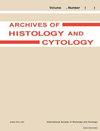Runx2转基因小鼠成牙细胞终末分化及其向成骨细胞转分化的抑制作用。
Q4 Medicine
引用次数: 84
摘要
Runx2是骨和牙齿发育的重要转录因子,其在成牙细胞分化中的作用尚不清楚。为了探究这一问题,我们研究了Col1a1启动子控制下Runx2转基因小鼠(Tg(Col1a1-Runx2)小鼠)的牙齿发育情况。在成牙前细胞、未成熟成牙细胞、牙囊间充质细胞和成骨细胞的细胞核中检测到内源性Runx2蛋白,在成牙细胞和成骨细胞中检测到转基因表达。Tg(Col1a1-Runx2)小鼠成牙细胞失去柱状,牙本质在成牙细胞周围沉积,呈长方体或扁平状。Tg(Col1a1-Runx2)小鼠的牙本质较薄,具有含有成牙细胞和骨小管样结构的腔隙,而牙本质前和牙本质小管缺失。我们通过原位杂交检测了牙本质基质蛋白基因Col1a1和牙本质唾液磷蛋白(DSPP)的表达,并通过免疫组织化学检测了牙本质基质蛋白、骨钙素、骨桥蛋白、牙本质基质蛋白1 (DMP1)以及中间丝蛋白巢蛋白的表达,以表征Tg(Col1a1- runx2)小鼠的成牙细胞。结果显示Tg(Col1a1- runx2)小鼠成牙细胞Col1a1表达下调,DSPP表达缺失,巢蛋白nestin表达严重降低。此外,骨钙素、骨桥蛋白和DMP1的表达在成牙细胞中上调,尽管骨钙素的表达上调是短暂的。这些结果表明,Runx2抑制成牙细胞的终末分化,并且Runx2诱导成牙细胞转分化为形成骨结构的成骨细胞。因此,在成牙本质分化过程中,Runx2的表达必须下调,以获得完整的成牙本质分化。本文章由计算机程序翻译,如有差异,请以英文原文为准。
Inhibition of the terminal differentiation of odontoblasts and their transdifferentiation into osteoblasts in Runx2 transgenic mice.
Runx2 is an essential transcription factor for bone and tooth development whose function in odontoblast differentiation remains to be clarified. To pursue this issue, we examined tooth development in Runx2 transgenic mice under the control of Col1a1 promoter (Tg(Col1a1-Runx2) mice). Endogenous Runx2 protein was detected in the nuclei of preodontoblasts, immature odontoblasts, mesenchymal cells in the dental sac, and osteoblasts, while transgene expression was detected in odontoblasts and osteoblasts. Odontoblasts in Tg(Col1a1-Runx2) mice lost their columnar shape and dentin was deposited around the odontoblasts, which were cuboid or flat in shape. The dentin in Tg(Col1a1-Runx2) mice was thin and possessed lacunae that contained odontoblasts and bone canaliculi-like structures, while predentin and dentinal tubules were absent. We examined the expression of dentin matrix protein genes, Col1a1 and dentin sialophosphoprotein (DSPP), by in situ hybridization, and dentin matrix proteins, osteocalcin, osteopontin, and dentin matrix protein 1 (DMP1) as well as an intermediate filament, nestin, by immunohistochemistry to characterize odontoblasts in Tg(Col1a1-Runx2) mice. Results showed Col1a1 expression was down-regulated, DSPP expression was lost, and nestin expression was severely decreased in the odontoblasts of Tg(Col1a1-Runx2) mice. Further, the expressions of osteocalcin, osteopontin, and DMP1 were up-regulated in odontoblasts, although the up-regulation of osteocalcin expression was transient. These findings indicate that Runx2 inhibits the terminal differentiation of odontoblasts, and that Runx2 induces transdifferentiation of odontoblasts into osteoblasts forming a bone structure. Thus, Runx2 expression has to be down-regulated during odontoblast differentiation to acquire full odontoblast differentiation for dentinogenesis.
求助全文
通过发布文献求助,成功后即可免费获取论文全文。
去求助
来源期刊

Archives of histology and cytology
生物-细胞生物学
自引率
0.00%
发文量
0
期刊介绍:
The Archives of Histology and Cytology provides prompt publication in English of original works on the histology and histochemistry of man and animals. The articles published are in principle restricted to studies on vertebrates, but investigations using invertebrates may be accepted when the intention and results present issues of common interest to vertebrate researchers. Pathological studies may also be accepted, if the observations and interpretations are deemed to contribute toward increasing knowledge of the normal features of the cells or tissues concerned. This journal will also publish reviews offering evaluations and critical interpretations of recent studies and theories.
 求助内容:
求助内容: 应助结果提醒方式:
应助结果提醒方式:


